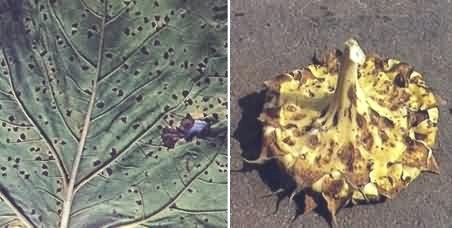Diseases
Alternaria sp. - Dark-Brown Spot of Sunflower
Systematic position.
Class Deuteromyces, order Hyphomycetales, genus Alternaria.Biological group.
Facultative parasite.Morphology and biology.
Alternaria helianthi, A. alternata, A. zinniea and other species are registered as the causative agents of sunflower alternariosis. On the affected plants they form spots of various shapes. At first the alternariosis is visible on cotyledons and later on true leaves, stalks, and heads. On the affected cotyledons the disease develops as rounded yellow spots to 0.3 cm in diameter. Alternariosis on true leaves shows up at first as small irregular-shaped spots, which later increase in size, causing complete drying of the leaves. On stalks and back surface of heads the disease develops as dark or brown strokes and spots of various shapes and sizes. Dark or olive sporulation of causative agent occurs on the affected tissue during humid weather. Sporulation is formed on short conidiophores with easily breaking chains of spores. The spores have longitudinal and cross septa; their size are 25-80 (120) x 8-11 microns (A. helianthi), 20-63 (37) x 9-18 (13) microns (A. alternata), 19.5-90 x 9-28.5 microns (A. zinniae). The source of initial infection by causative agents are the over-wintered affected plant residues and seeds of sunflower and other host plants.Distribution.
Alternariosis of sunflower is spread everywhere throughout Russia and other countries of the former USSR. According to our estimation, the fungus A. helianthi is found on sunflower more often than other causative agents.Ecology.
The disease is present during all stages of sunflower development, but most intensively during ripening. Prolonged damp weather and air temperatures of 15 to 30.C are favorable for infection of sunflower by pathogens. Maximum infection of sunflower by A. helianthi occurs at temperatures of 25-27.C with continuous damp weather over three or four days.Economic significance.
Alternariosis causes premature drying of sunflower that results in appreciable yield losses. The disease is more severe in the Northern Caucasus, Ukraine, and Moldova, where yield losses may reach 30% on the average. In order to control this disease it is necessary to use less susceptible varieties and hybrids, rotate sunflowers and use a pre-sowing treatment of seeds.Reference citations:
Kukin V.F. 1982. Diseases of sunflower and their control. Moscow: Kolos. 80 p. (In Russian)Pidoplichko N.M. 1977. Fungal parasites of cultural plants. Guide, V. 2. Kiev: Naukova Dumka. 163-187 p. (In Russian)
Rarancius S. 1999. Alternaria sp. IX FAO technical consultation of the European cooperative research network on sunflower; 1999, July 27-30; Dobrich, Bulgaria. Reports. FAO and IWS.
Tikhonov O.I. 1975. Diseases of sunflower. In: Pustovoit V.S., ed. Sunflower. Moscow: Kolos. 401-409 p. (In Russian)
Yakutkin V.I. 2001. Diseases of sunflower in Russia and their control. Zashchita i karantin rastenii, 10: 26-29. (In Russian)


